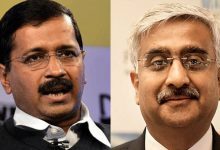The keenness of the BJP-led government runs contrary to its party’s pledge of ‘flourishing agriculture’ taken in its 2014 election manifesto, as well as the government’s own emphasis on adopting a multi-dimensional seven-point strategy. In fact, the government shrewdly says everything that sounds wonderful while concealing its real intention in the camouflage of policy statements. Here’s an analysis, for Different Truths.
The government is keen to make agriculture policies and programs ‘income centric’ instead of ‘production-oriented’. It has been revealed by Union Minister of Agriculture and Farmers Welfare Radha Mohan Singh while addressing the National Conference on “Agriculture 2022 – Doubling Farmers’ Income”. Such policy experiments in agriculture, if the government goes ahead with it, may sabotage food self-sufficiency at the national level, which we have achieved through decades of hard work, though food self-sufficiency at the individual level has remained a dream to be realised. The nation could not afford to let agriculture production to fall and focus only on doubling the farm income by 2022 as Prime Minister Narendra Modi had announced in April 2017.
The keenness of the BJP-led government runs contrary to its party’s pledge of ‘flourishing agriculture’ taken in its 2014 election manifesto, as well as the government’s own emphasis on adopting a multi-dimensional seven-point strategy, the first two of which include emphasis on irrigation along with end to end solution on creation of resources for ‘more crop per drop’, and ‘provision of quality seeds and nutrients according to the soil quality of each farm’, through which government cleverly misleads people with the impression that the ‘production oriented’ policy is still the top priority. In fact, the government shrewdly says everything that sounds wonderful while concealing its real intention in the camouflage of policy statements. The other five points of priorities are: large investments in warehouses and cold chains to prevent post-harvest losses, promotion of value addition through food processing, implementation of National Agricultural Markets and e-platforms (e-NAM) to eliminate shortcomings of all the 585 centers, to mitigate the risk, introduction of crop insurance scheme at a lower cost; and promotion of allied activities such as dairy-animal husbandry, poultry, bee-keeping, horticulture, and fisheries.
Focussing on ‘income centric’ agricultural programme and policies instead of ‘pproduction-oriented is being pursued in the backdrop when the growth in agriculture sector is falling sharply for the last four years. The advance estimate for the current financial year has put the growth rate at 2.1 percent in its Gross Value Added (GVA) as against the previous year’s growth rate of 4.9 percent. The number of cultivators in 2004-05 were 16.61 crores, which has reduced to 13.60 crores in 2015-16 because the cost of farming has increased on the one hand and uncertainty of climate on the other has made this sector more troublesome with declining productivity. Farmers are increasingly fed up with their activity and leaving it in favour of other sectors. It is an ominous sign. It should be prevented not only by increasing the farm income, as it is proposed, but also through increasing productivity and production by giving it a top priority.
The Central Statistics Office (CSO), Ministry of Statistics and Programme Implementation, has compiled a report on the information given by the Department of Agriculture and Cooperation (DAC), which said that the production of food grains during the Kharif season of the agriculture year 2017-18 was 134.67 million tonnes as compared to 138.52 million tonnes during the same period in 2016-17. This shortfall of over 40 lakh tone in one year and only in Kharif foodgrains is something alarming. Moreover, due to increase in population our requirement is much more.
Using district-level data on temperature, rainfall and crop production, even the Economic Survey 2017-18 has documented a long-term trend of rising temperatures, declining average rainfall, an increase in extreme precipitation events. A key finding—and one with significant implications as climate change looms—is that the impact of temperature and rainfall is felt only in the extreme; that is, when temperatures are much higher, rainfall significantly lower, and the number of “dry days” greater, than normal. A second key finding is that these impacts are significantly more adverse in un-irrigated areas (and hence rainfed crops) compared to irrigated areas (and hence cereals). Applying these estimates to projected long-term weather patterns implies that climate change could reduce annual agricultural incomes in the range of 15 percent to 18 percent on average, and up to 20 percent to 25 percent for unirrigated areas. At current levels of farm income, that translates into more than Rs. 3,600 per year for the median farm household. Minimizing susceptibility to climate change requires drastically extending irrigation via efficient drip and sprinkler technologies (realising “more crop for every drop”). More broadly, the cereal-centricity of policy needs to be reviewed. The price hike for agricultural product may arrest some of the financial shocks to cultivators, but there are many other important issues involved, such as cost escalation and inflation.
The Survey has rightly said that the Prime Minister’s goal of doubling farmer’s incomes increasingly runs up against the contemporary realities of Indian agriculture. Shifting focus of income rather than production would prove a dangerous experiment because with falling production and increasing the population to feed would make our people in larger number who may not get two square meal daily. Even at the present level of production, we have 26 percent of our people living below poverty line who are not getting two squire meals daily. This is the cause that we have crores of people suffering from malnutrition-related ailments.
The seven-point programme for doubling farmer’s income is misleading because the level of investment we need for that has not been provided even in the Union Budget 2018-19. Union Minister for Agriculture and Farmer’s Welfare has claimed that the budget for agriculture has been increased from Rs.51,576 crore in 2017-18 to Rs.58,080 crore for the year 2018-19 while ensuring sufficient funds for each component of the Seven-Point Strategy. This is simply untrue because the actual need for the agriculture sector was estimated for the for the 12th five-year plan (2012-17) at Rs 3,23,024 crore but only 41.80 percent of this amount was approved. Even out of the approved Rs 1,34,746 crore, only Rs 88,322 crore were expended until the end of 2016-17. The amount required was on the base prices of 2011-12. When calculated at current prices, the difference between the required amount and the amount actually given will be very high.
This government came in 2014 and repeatedly claiming that they are doing everything for the farmers and the agriculture sector. However, the budgeted amounts and the actual expenditures do not reflect their seriousness towards this sector. In 2014-15, the actual expenditure was Rs 19,513 crore as against the budgeted provision of Rs 22,652 crore. Actual expenditure in 2015-16 fell down to Rs 15,333 crore as against the budget of Rs 17,004 crore. The year 2016-17 witnessed an increase in actual expenditure which rose to Rs 40,585 crore as against the budget of Rs 35,983 crore. For the year 2017-18 the budget allocation is Rs 52,655 crore. It is not commensurate with the requirement and, therefore, various activities and programmes are being hampered.
It should also be kept in mind that agriculture matters not only for economic reasons but also its share in the employment, which is about 49 percent, and livelihood of cultivators and agricultural labourers, which is around 70 percent of our total population. We also need to maintain food self-sufficiency at national and individual level. We should also keep in mind that we have the Food Security Act, and the government is bound to secure food for all. Moreover, poor agricultural performance can lead to inflation, farmer distress and unrest, and larger political and social disaffection—all of which can hold back the economy, though its share in the GDP is only 16 percent.
Gyan Pathak
©IPA Service
Photo from the Internet
#FarmersWelfare #PoliticalAndSocialDisaffection #Economy #GDP #CentralStatisticsOffice #Suvey #GrossValue #UnionMinister #IPA #DifferentTruths





 By
By

